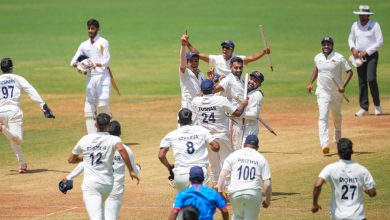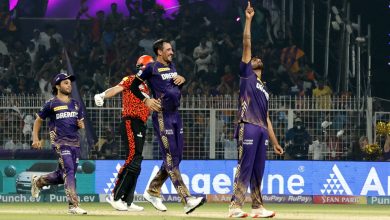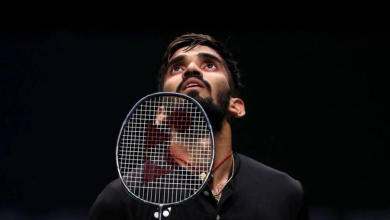SA vs IND: Can Shubman Gill erase his one technical weakness, and prove he’s the best young Indian batsman in South Africa? | Cricket News

For a while now, Shubman Gill has been rightly touted as the next big thing in Indian cricket but there is one issue that has been pegging him back: the slow weight-transfer onto the front foot that has often seen him losing his stumps or being trapped LBW or spooning a return catch to full-length deliveries.James Anderson, Kyle Jamieson, Mohammad Shami (in the IPL), Chris Woakes, Tim Southee and Pat Cummins have all been successful with that delivery against him.
It’s not Gill who is going around saying he is the next big thing, but once that label sticks and hype is built, questions pop up automatically – as an expectation from a best-of-the-generation player, rather than harsh criticism.
A good batsman can fall like that, but an aspirant to the throne should be better than just good. It’s not that Sunil Gavaskar, the man who knew his off-stump, never edged behind, but it wasn’t a palpable weakness that worked for the bowler every time. It’s not as if Sachin Tendulkar didn’t fall LBW to in-dippers, but it wasn’t a weakness that was consently exploited. It’s not as if Brian Lara wasn’t troubled bouncers.
“Has he started to shift his weight forward better?”
It was a query from Kane Williamson’s longtime batting coach David Johnston, in Shubman Gill’s international debut year. “I saw him as an U-19 kid here in New Zealand, excellent batsman; just had one area of concern when the ball is on a good length and nips back in.
“His whole set-up is such that he prefers standing tall at the crease or pushing back, and is late in getting forward. He should be fine in Australia or South Africa’s bouncy conditions but might have a few issues in England, New Zealand and elsewhere where that kind of bounce isn’t there. But it’s just a small thing, he is too talented not to have sorted it. But yeah, just keep an eye on it.”
Amazingly, Gill hasn’t sorted it yet, and it has often been his downfall in international cricket. As predicted Williamson’s coach, he sparkled in Australia in 2021, but that flaw has proved to be his downfall elsewhere.
It’s not a weakness in the conventional sense of the word. If he corrects it in the conventional manner of pressing forward, it can affect his whole successful set-up at the crease that he is understandably loath to change. It’s a natural technique that developed from his childhood days of playing on cement tracks in his village courtyard. It demanded him to stand tall and punch on the up or press back and f. It’s also a reason for his short-arm swat pulls to look so natural when the ball bounces up from even back of a length.
To change that with possibly a tiny forward-trigger is to mis-shape his natural set-up. So he has tried to offset it with other means. Chiefly, with an exaggerated front-shoulder lean-in stance in his last few Tests. Almost as if reminding himself that he can’t afford to have his weight back too much, and should be ready to spring forward when the length demands it. It works, but then comes the ball, after a series of set-ups the bowler, when he finds himself a tad late in moving forward. And that’s all really good bowlers need.
Scott Boland celebrates the wicket of India’s Shubman Gill during the 2023 World Test Championship Final at The Oval. (Reuters)
Awareness leads to solution
In many ways, batting is about transferring weight and being still when playing a shot. Unlike Williamson, who looks to get forward with a small press but then that step is just the start of Williamson’s negotiations, not the end.
“From that forward press, depending on the length, Kane either pushes back or gets forward further,” Johnston says. “He doesn’t allow the bowler to dictate lengths being crease bound.” Gill does.
It’s not that he isn’t aware of the problem. “There are one or two important elements. Like your shoulder should be aligned towards the ball, you should be a little side-on while playing, you should be in a good position even if your feet are not moving that well. If you are positioned well in relation to the ball, you will manage,” Gill once told The Indian Express.
To his credit, he has great hands and trusts them to get him out of jail but when the ball moves a bit from that full good length, he is asking too much of them.
Gill is a very self-aware batsman who has pieced his technique minutely. “As a player, you should know what things you need to work on, and where the opposition is looking to get you out. If you know that, it becomes easier to tackle,” Gill had said. “I don’t make any big changes to my technique without talking to my father… In cricket, there is no technique that can be termed ‘out-proof’”, he told this newspaper.
To his credit, Gill has great hands and trusts them to get him out of jail but when the ball moves a bit from that full good length, he is asking too much of them.. (PTI)
Clearly, he does see the weight-transfer as an issue as he has tried to offset it reducing his initial back-foot movement. Also, for a brief while in the recent past, he would stand with a noticeable lean-in of the front shoulder. So he has tinkered around.
One of his mentors, Abhishek Nayar, former Mumbai batsman and a coach with Kolkata Knight Riders, had told this newspaper about Gill’s mental make-up as a batsman.
“Lot of cricketers spend a lot of time trying to understand their game. But Gill is someone who has that deep understanding at a young age. He is someone who relies a lot on his technique. He has a great deal of understanding about his own game and about the complexities of his skill set.
“On concrete, the back foot becomes natural, an instinctive shot. And the front foot becomes something you have to develop,” Nayar said. “He isn’t someone who you will see leaning into drive as that is not something that comes naturally, but he is someone who has scored a lot of runs off the red ball on the front foot. I think he has an all-round game.”
Now, in South Africa, though there is no Anrich Nortje who deals in that good length with pace, he will be up against Kagiso Rabada and Lungi Ngidi, a tall left-handed seamer in Marco Jansen as well as right-arm pacer Gerald Coetzee. In theory, as Williamson’s coach said, Gill should prosper in South African conditions as he did in Australia, but if the pacers have done their homework aligned with the demands of the conditions, it can get tricky.
If cloudy conditions force the South African pacers to hit a full length in search of movement, rather than hurl it short of length as they might do on home tracks, it can get interesting for Gill. The best young Indian batsman of this generation, on paper, has to show that he is the best young Indian batsman of this generation – on the field.







